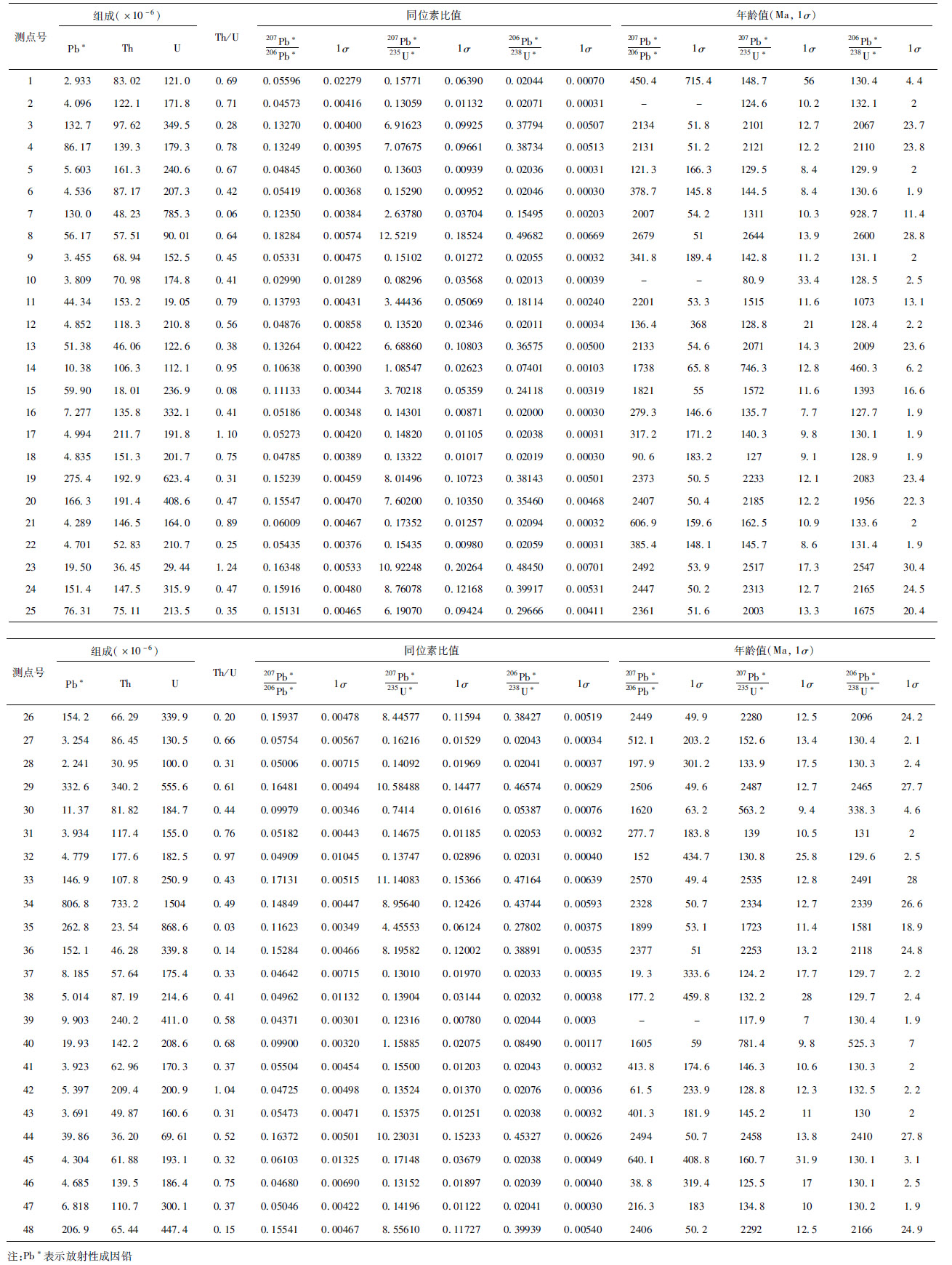2. 大陆动力学国家重点实验室, 西北大学地质学系, 西安 710069
2. State Key Laboratory of Continental Dynamics, Department of Geology, Northwest University, Xi'an 710069, China
克拉通地体是地球上稳定的构造单元,由上部的地壳和下部的岩石圈地幔共同组成。华北克拉通作为太古宙古老克拉通之一,其东部的岩石圈地幔在中生代时发生了近120km减薄(Griffin et al.,1992,1998; Menzies et al.,1993,2007; 邓晋福等,1994),并且岩石圈地幔由古老的、冷的、富集的特点转变为具有年轻的、热的、亏损的“大洋型”岩石圈地幔的特点(Fan and Menzies,1992; Fan et al.,2000; 郑建平,1999; Gao et al.,2002a,2004; Rudnick et al.,2004)。对华北中西部地区地幔捕掳体研究表明,其下部岩石圈地幔具有太古代岩石圈地幔组成的特点,暗示华北克拉通中生代的去克拉通化过程只限于克拉通东部地区(Xu et al.,2010a,b; Ying et al.,2010b)。在华北克拉通中部,分布有与华北地块去克拉通化作用时代一致的岩浆岩,这些岩石的形成与强烈的壳-幔相互作用有关(Chen et al.,2003a,b,2004,2008; 蔡剑辉等,2003; 彭头平等,2004; Wang et al.,2006; Ying et al.,2007,2011)。下地壳作为壳-幔相互作用的关键部位,可以有效地反映壳-幔物质作用和物质循环等化学地球动力学重要信息。我们对下地壳物质组成的研究可以从年轻火成岩中的下地壳捕掳体、出露的下地壳剖面及源于深部地壳的火成岩微量元素及同位素特征等三个方面入手(张旗等,2001)。目前发表的华北下地壳捕掳体研究主要集中在汉诺坝(樊祺诚和刘若新,1996; 樊祺诚等,1998; 张国辉等,1998)、女山新生代玄武岩(黄小龙等,2002; Huang et al.,2004)、信阳中生代玄武岩(Zheng et al.,2003; 郑建平等,2005),山东莒南麻粒岩捕掳体(Ying et al.,2010a)、复县金伯利岩中的麻粒岩捕掳体(郑建平等,2005)。这些捕掳体分布在华北东部和北部地区,因此我们不能直接利用麻粒岩捕掳体来研究华北中南部和西部地区的下地壳组成特征。麻粒岩地体作为出露的下地壳剖面,一般反映其抬升到地表之前的深部地壳组成信息及结构特征,不能完全反映其抬升之后的深部地壳性质,而花岗质岩石地球化学示踪研究可以有效弥补依靠下地壳麻粒岩包体和麻粒岩地体示踪下地壳成分研究的局限,有利于提取深部陆壳地球化学信息(Farmer,1992)。基于这一思路,本文选取华北克拉通中部带南部地区早白垩世孤峰山花岗闪长岩和蚕坊花岗闪长岩为研究对象,在孤峰山岩体年代学和元素地球化学研究的基础上(齐玥等,2011),结合蚕坊岩体的地球化学和两个岩体的同位素地球化学研究,探讨华北克拉通中南部下地壳组成信息和壳-幔相互作用的响应。
1 地质概况华北克拉通构造格架如图 1a所示,华北克拉通陆壳的90%形成于早前寒武纪(翟明国等,2001; 翟明国和刘文军,2001),东部陆块的基底岩石主要为太古代TTG和花岗质岩石,还有大量的太古代花岗质片麻岩及盖层(Zhao et al.,2000,2001);中部带主要为再沉积的太古代岩石及晚太古代到古元古代的火成岩和沉积岩,包含有2.5~2.7Ga的角闪岩相到麻粒岩相的地体(Zhao et al.,2000,2001);西部带主要出露有晚太古代到古元古代的地层不整合覆盖在太古代基底上(Zhao et al.,2000);在古元古代末1.95~1.85Ga,华北克拉通经过陆块碰撞拼合完成终极克拉通化(Zhao et al.,2000)。研究区位于华北克拉通中部带南部(图 1b)。这一地区出露有较多的中酸性岩石,主要为花岗闪长岩、二长花岗岩及一些碱性岩,主要以岩株的形式产出。
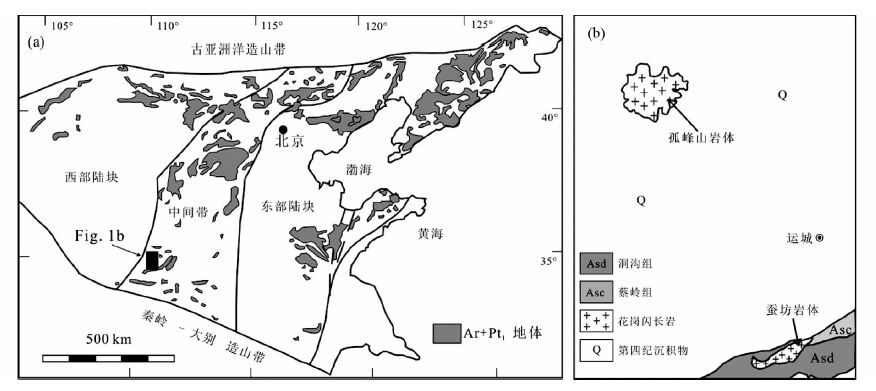
|
图 1 华北克拉通地质简图(a)和运城地区地质简图(b)(据山西省建委地质局区域地质测量队,1972①①山西省建委地质局区域地质测量队.1972.运城幅1:20万地质图;煤炭科学研究总院西安分院,1991② 修改②煤炭科学研究总院西安分院.1991.韩城幅1:20万地质图) Fig. 1 Geologic sketch map of the North China craton(a)and geological map of the Yuncheng area(b) |
孤峰山花岗闪长岩体出露于山西省运城市西北部,岩体呈孤山峰,四周被第四纪黄土沉积物覆盖,出露面积约22km2。岩性主要是灰白色花岗闪长岩,具中细粒-细粒花岗结构,块状构造,主要矿物组成有酸性斜长石(35%~40%,An<28),中长石(10%~15%,具有明显的环带结构),钾长石(20%~25%),石英(15%~20%),角闪石(5%~8%),副矿物有磷灰石、磁铁矿和锆石等。
蚕坊花岗闪长岩体位于运城市西南部,岩体侵入于西姚片麻岩中,斜交围岩。北东东-南西西向延伸,呈板状岩株,长4.4km,宽1~1.5km,出露面积约6km2。岩性主要为花岗闪长岩,灰白色、灰肉红色、中粒似斑状半自形-他形粒状结构,主要矿物组成为酸性斜长石(50%~55%,An=10~25)、钾长石(20%)、石英(15%~20%)、角闪石(3%~5%)、黑云母(1%~3%),副矿物为榍石、磷灰石和锆石等。
2 样品分析方法主量元素和微量元素含量分析在西北大学大陆动力学国家重点实验室完成。Fe2O3T和烧失量(LOI)采用湿法化学法分析,其它主量元素利用碱熔玻璃片在日本理学RIX2100X荧光光谱仪(XRF)上测定,分析相对误差一般小于2%。微量元素分析在美国Perkin Elmer公司Elan6100DRC型电感耦合等离子质谱仪(ICP-MS)上进行,相对误差一般小于2%~5%。
锆石矿物分选在河北廊坊区域地质调查所实验室完成。在双目显微镜下挑纯得到的锆石样品置于环氧树脂中打磨,暴露出锆石的中心面,用于阴极发光(CL)和LA-ICP-MS方法U-Pb同位素组成分析。CL图像在西北大学大陆动力学国家重点实验室完成,CL发光仪加载于扫描电镜上的美国Gatan 公司Mono CL3+型阴极荧光探头。锆石U-Pb同位素组成利用西北大学大陆动力学国家重点实验室的四极杆ICP-MS Elan6100DRC进行测定。激光剥蚀系统为德国MicroLas公司生产的GeoLas200M,采用He作为剥蚀物质的载气,以美国国家标准技术研究院研制的人工合成硅酸盐玻璃标准参考物NIST610进行仪器最佳化。分析采用激光束斑直径为30μm,激光脉冲为10Hz,能量为32~36mJ。测量的同位素组成采用锆石91500进行外标校正。详细的LA-ICP-MS分析方法和流程参见Gao et al.(2002b)和袁洪林等(2003)。
Rb-Sr、Sm-Nd和Pb同位素的化学分离纯化和同位素比值测量在中国科学技术大学壳幔物质与环境重点实验室完成。Rb-Sr同位素和REE分离纯化在装有5mL AG50W-X12交换树脂(200~400目)的石英交换柱中完成,Sm-Nd同位素的分离纯化在装有1.7mL Teflon粉末的石英交换柱中完成。Pb同位素分离纯化在AG1-X8阴离子交换树脂(200~400目)中完成。同位素比值的测试在MAT-262热电离质谱计完成,Rb-Sr同位素比值测定采用Ta金属带和Ta发射剂;Sm-Nd同位素比值测定采用Re金属带,Pb同位素比值测试采用单Re金属带并以硅胶为发射剂。测量得到的同位素比值采用86Sr/88Sr=0.1194和146Nd/144Nd=0.7219进行质量分馏校正。重复分析标准溶液NBS 987和La Jolla,分别得到87Sr/86Sr值为0.710249±0.000012和143Nd/144Nd值0.511869±0.201607066。Pb标准溶液NBS 981的测量结果用于Pb同位素的质量分馏校正。具体的化学分析流程和同位素比值测定流程可以参见Chen et al.(2000,2007)。
3 分析结果 3.1 锆石U-Pb年龄蚕坊花岗闪长岩体代表性的锆石CL图像如图 2a所示,可分为二类:第一类锆石有明显的核边结构,内部为继承核,外部为振荡环带,其中有些锆石具有较小的增生边,达不到测量要求;第二类为内部结构均匀,晶体呈短柱状自形晶,有明显的振荡环带结构的锆石,Th/U较高(0.50~0.92),显示典型岩浆锆石的特征。对26颗锆石进行U-Pb同位素测年,共48个测点,所得数据见表 1,其中第7和第35测点代表混合年龄,在计算岩石形成年龄时舍去。锆石年龄主要分为两组:自形较好,具振荡环带的岩浆锆石年龄主要集中在128~134Ma之间,206Pb/238U年龄加权平均值为130.3±0.8Ma(MSWD值0.38;图 3a),代表岩体的结晶年龄。在误差范围内,这一年龄值与前人报道的129Ma 40Ar-39Ar年龄一致(王冬艳等,2005)。继承锆石的谐和年龄主要集中在2100~2630Ma之间,与华北克拉通中部带的构造-热演化历史吻合(Zhao et al.,2001),可能代表岩浆源区的继承或捕获锆石。
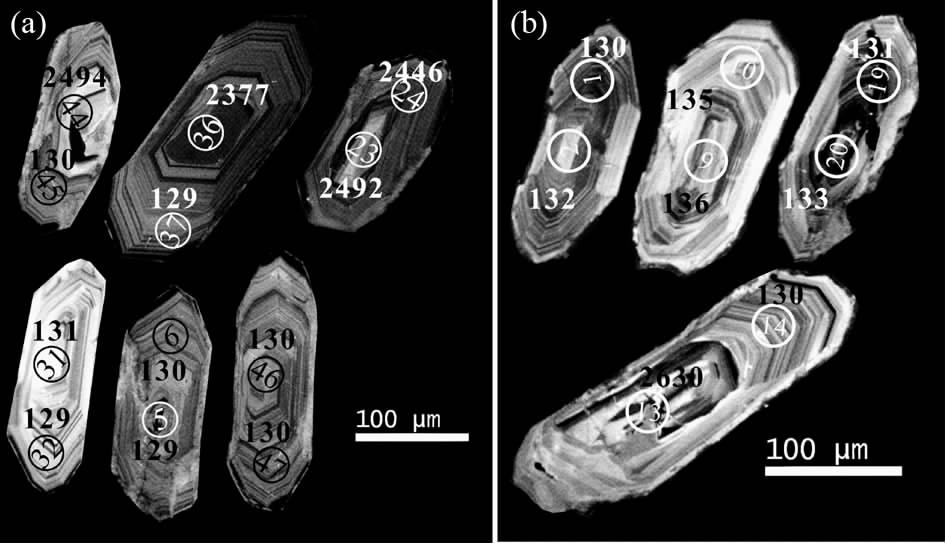
|
图 2 蚕坊岩体(a)和孤峰山岩体(b)的代表性锆石CL图像 孤峰山岩体引自齐玥等(2011) Fig. 2 CL images of representative zircon grains of the Canfang(a)and Gufengshan plutons(b) |
|
|
表 1 蚕坊花岗闪长岩锆石U-Pb同位素分析表 Table 1 Zircon U-Pb isotopic data of the Canfang granodiorite |
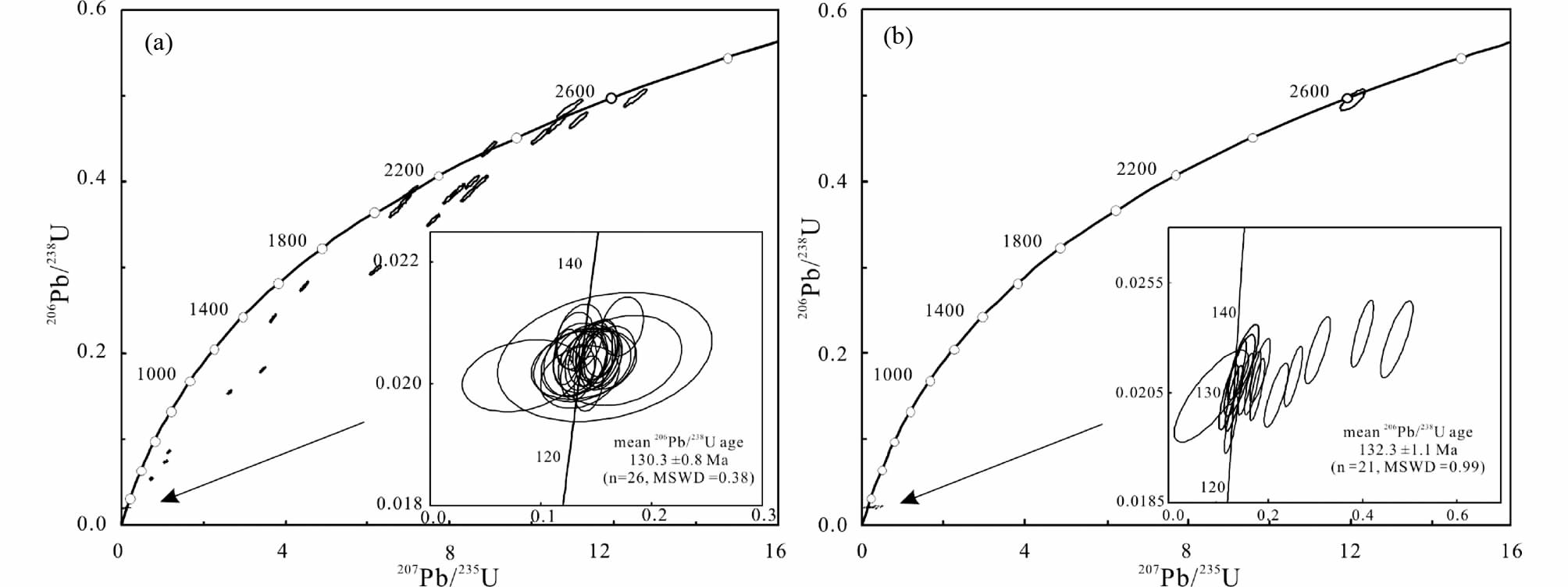
|
图 3 蚕坊岩体(a)和孤峰山岩体(b)锆石U-Pb年龄谐和图 孤峰山岩体根据齐玥等(2011)报道的分析数据重新计算和制图 Fig. 3 Zircon U-Pb concordia diagrams of the Canfang(a)and Gufengshan(b)plutons |
蚕坊花岗闪长岩(CF)主量和微量元素组成列于表 2。岩体SiO2 含量为67.43%~68.99%(平均68.11%),显示富铝特征(Al2O3为16.02%~16.69%),A/NCK值为0.96~1.01,属于准铝质-弱过铝质系列。Na2O+K2O含量为7.70%~8.49%,里特曼指数(σ值)为2.28~2.92,相对富钠(Na2O/K2O比值1.22~1.63),属于高钾钙碱性岩石(图 4);镁指数偏低(Mg#值30.2~35.3<45)。
|
|
表 2 蚕坊花岗闪长岩的主量(wt%)和微量(×10-6)元素含量 Table 2 Contents of major(wt%)and trace(×10-6)elements of the Canfang granodiorite |
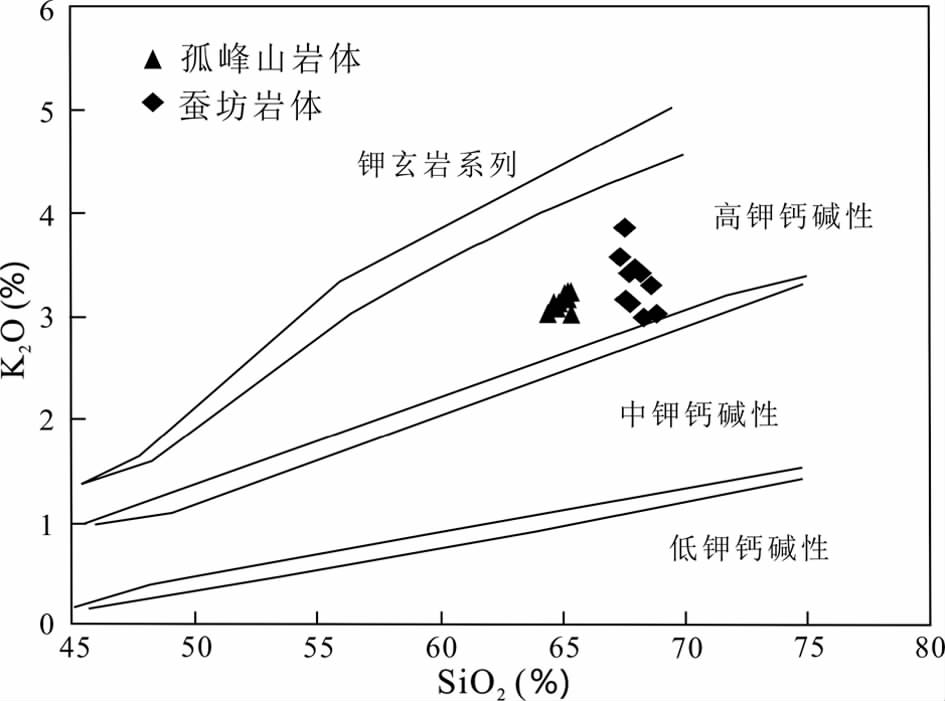
|
图 4 蚕坊花岗闪长岩的SiO2-K2O图解(底图根据Rickwood,1989) 孤峰山岩体数据引自齐玥等(2011) Fig. 4 SiO2-K2O diagram of the Canfang granodiorite pluton(base map after Rickwood,1989) |
岩石稀土元素含量较高,∑REE含量为153.7×10-6~190.8×10-6(平均168×10-6),除样品CF11的(La/Yb)N较大外,其余样品变化在22.0~31.5之间,显示强烈的轻重稀土分异;除样品CF11的(Gd/Yb)N值相对较高外,多数样品变化在2.53~3.04,表示没有明显的重稀土分异,符合重稀土元素配分模式相对平坦的特征(图 5a);显示弱的铕正异常(δEu值1.05~1.15)。在原始地幔标准化图解上(图 5b),岩石富集轻稀土元素和大离子亲石元素,亏损Nb、Ta、Ti高场强元素和重稀土元素,具有明显的Pb正异常。岩石Sr和Ba含量较高(Ba 1180×10-6~2261×10-6;Sr 1049×10-6~1244×10-6),Y和重稀土Yb含量较低(Y 9.2×10-6~13.0×10-6;Yb 0.57×10-6~1.12×10-6),高Sr/Y比值特征(81~129)。

|
图 5 蚕坊花岗闪长岩稀土元素组成特征(a,球粒陨石值据Boynton,1984)和微量元素组成特征(b,原始地幔值据Sun and McDonough,1989) Fig. 5 Chondrite-normalized REE-pattern diagram(a,normalization values after Boynton,1984)and primitive mantle-normalized diagram of trace elements(b,normalization values after Sun and McDonough,1989)of the Canfang granodiorite |
蚕坊和孤峰山岩体的全岩Rb-Sr、Sm-Nd、Pb同位素分析结果列于表 3和表 4中。回扣到130Ma时,孤峰山岩体的初始87Sr/86Sr比值为0.70698~0.70742,初始εNd值变化在-16.5~-15.6之间,不同于华北中部富集岩石圈地幔的特征(图 6);全岩的初始206Pb/204Pb、207Pb/204Pb和208Pb/204Pb比值分别为17.284~17.305,15.337~15.352和37.695~37.740,高Δ8/4值(114.6~121.2),暗示源区具有高Th/U比。蚕坊岩体的同位素组成特征与孤峰山岩体相似,初始87Sr/86Sr比值为0.70709~0.70750,初始εNd值为-18.2~-15.7,初始206Pb/204Pb、 207Pb/204Pb和208Pb/204Pb比值分别为17.160~17.459,15.336~15.371和37.484~37.822;高Δ8/4值(102.8~113.0)。在207Pb/204Pb-206Pb/204Pb图解中(图 7a),孤峰山岩体和蚕坊岩体Pb同位素组成趋近于下地壳特征。
|
|
表 3 孤峰山和蚕坊花岗闪长岩Rb-Sr和Sm-Nd同位素组成 Table 3 Rb-Sr and Sm-Nd isotopic composition of the Gufengshan and Canfang granodiorite plutons |
|
|
表 4 孤峰山和蚕坊花岗闪长岩Pb同位素组成 Table 4 Pb isotopic composition of the Gufengshan and Canfang granodiorite plutons |
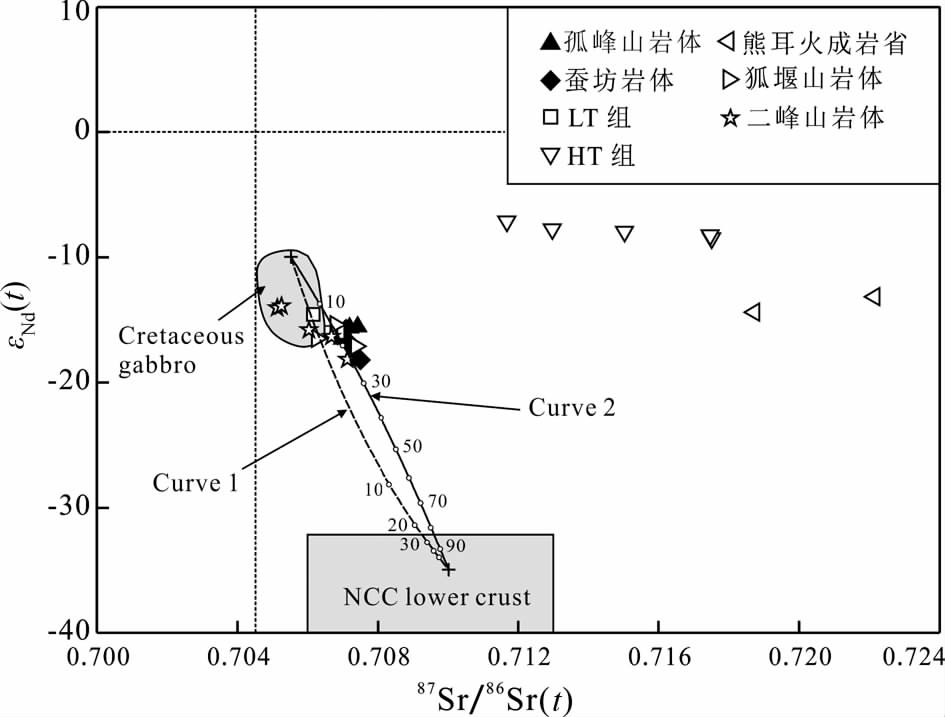
|
图 6 蚕坊岩体和孤峰山岩体Sr-Nd同位素组成 文献数据来源:早白垩世辉长岩(Zhang et al.,2004),华北克拉通下地壳(Jahn et al.,1999),LT组、HT组、熊耳火成岩省(Zhao et al.,2002; Peng et al.,2007,2008),狐堰山岩体及二峰山岩体(Ying et al.,2011). Curve 1代表中生代富集岩石圈地幔与华北古老下地壳的混合模型,Curve 2代表中生代富集岩石圈地幔来源的玄武质岩浆与华北下地壳物质的混合模型. 混合计算采用的常数:富集岩石圈地幔87Sr/86Sr(t)比值0.7055,εNd(t)值-10,Sr含量20×10-6,Nd含量1×10-6;玄武质岩浆87Sr/86Sr(t)比值0.7055,εNd(t)值-10,Sr含量150×10-6,Nd含量15×10-6(Zhang et al.,2004; Xu et al.,2004);华北古老下地壳87Sr/86Sr(t)比值0.7100,εNd(t)值-35,Sr含量300×10-6,Nd含量24×10-6(Jahn et al.,1999) Fig. 6 Sr-Nd isotopic composition of the Canfang and Gufengshan plutons |
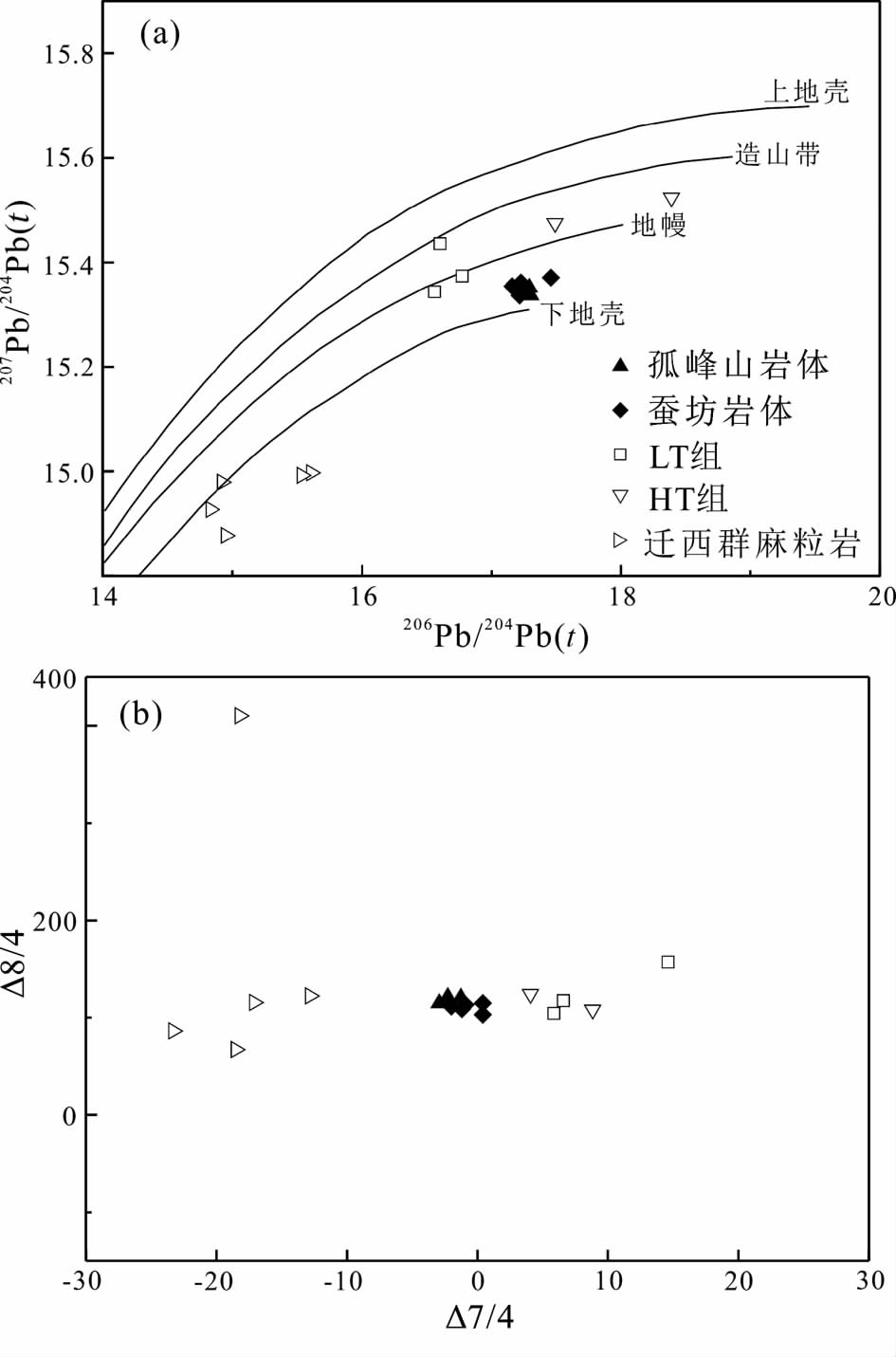
|
图 7 蚕坊岩体和孤峰山岩体Pb同位素组成(a,底图据Zartman and Doe,1981)和Δ7/4-Δ8/4关系图(b) Fig. 7 Pb isotopic composition of the Gufengshan and Canfang plutons(a,base map after Zartman and Doe,1981)and initial Δ7/4 versus Δ8/4 diagram(b) |
在地球化学组成上,蚕坊花岗闪长岩体具有高硅含量(67.4%~69.0%)、富钠(Na2O/K2O比值1.22~1.63)和低MgO含量(Mg#值31.8~36.2<45),与下地壳脱水熔融形成的熔体具有相似的主量元素组成特征(Rapp and Watson,1995);岩石富集轻稀土元素和大离子亲石元素(如Rb、Ba、Sr、K等),亏损高场强元素(如Nb、Ta、Ti等),显示明显的Pb正异常,具有壳源岩石的特征。对比显示,蚕坊岩体在主量和微量元素组成特征上与孤峰山岩体基本一致(齐玥等,2011)。
在SiO2-87Sr/86Sr(t)和SiO2-εNd(t)同位素图解中(图 8),初始87Sr/86Sr比值和初始εNd值与SiO2含量没有正相关关系,暗示在侵位过程中,两个岩体没有遭受中上地壳明显的同化混染作用,其同位素特征可以代表岩浆源区的同位素特征。华北克拉通太古代的下地壳主要由麻粒岩组成(Jahn and Zhang,1984; Zhao et al.,2001),根据报道的同位素组成(Jahn et al.,1999),在130Ma时,华北克拉通古老下地壳87Sr/86Sr比值变化在0.706~0.713之间,εNd值在-44~-32之间。蚕坊岩体和孤峰山岩体的Sr-Nd同位素特征(初始87Sr/86Sr比值范围0.7071~0.7075和0.7070~0.7074,初始εNd值范围-18.2~-15.7和-16.5~-15.6),与华北古老下地壳同位素特征明显不同(图 6),而两个岩体中具有明显的核边结构锆石的核部年龄却显示岩浆源区有华北古老下地壳物质贡献,表明岩浆的源区需要有地幔物质的加入。根据统计华北克拉通中部带基底岩石两阶段Nd模式年龄(tDM2)主要集中在2.8~2.4Ga,平均2.7Ga(Wu et al.,2005),而蚕坊岩体和孤峰山岩体的tDM2年龄值主要集中在2.2~2.4Ga,小于2.7Ga,也暗示岩浆源区具有地幔物质加入。因此,我们需要对地幔物质加入的方式及时间进行讨论。
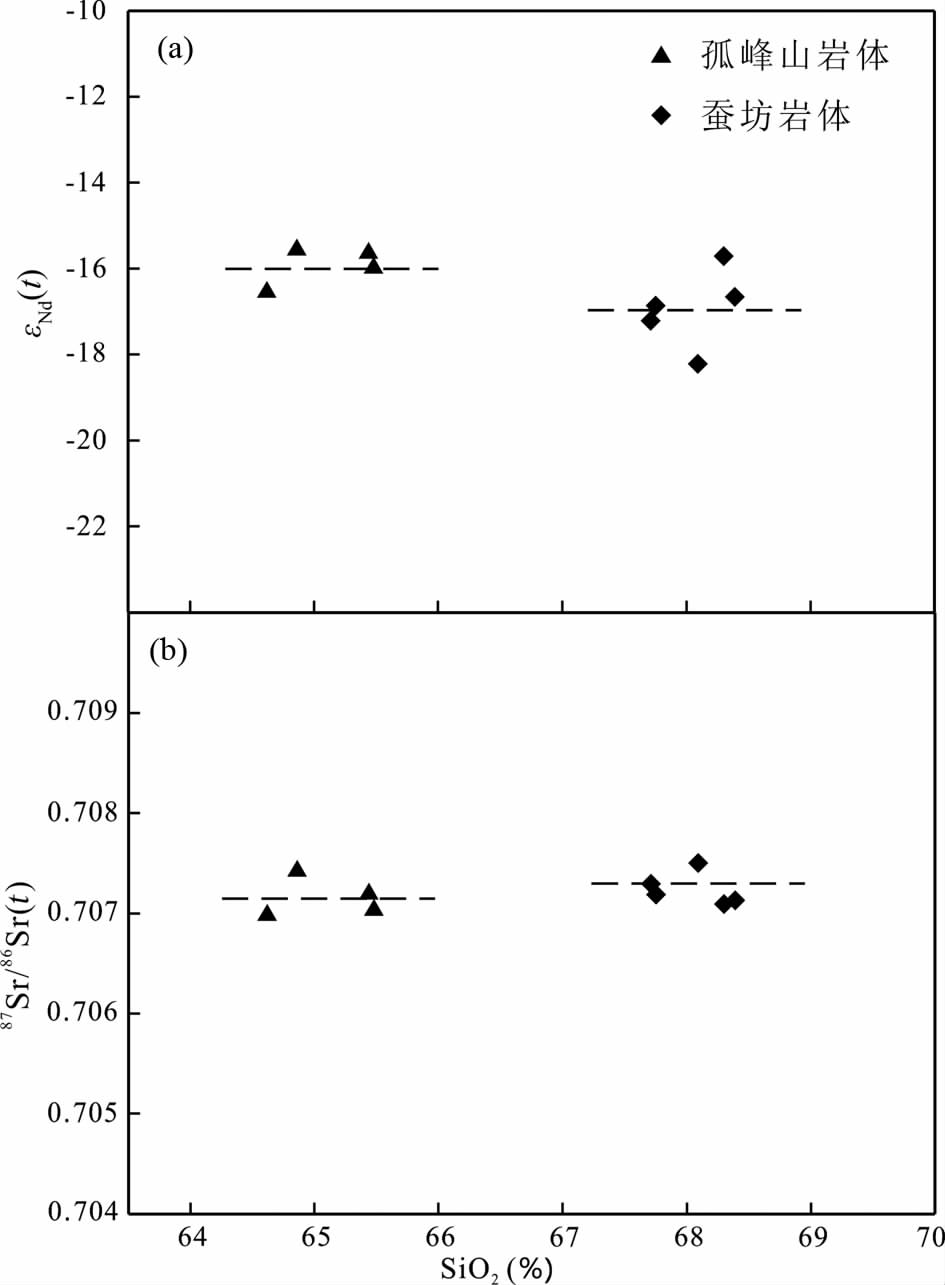
|
图 8 蚕坊岩体和孤峰山岩体SiO2和Sr-Nd同位素相关图解 Fig. 8 SiO2 contents versus initial 87Sr/86Sr and initial εNd values of the Canfang and Gufengshan plutons |
地幔物质参与花岗质熔体的岩浆作用可以通过两种方式,一种是岩浆混合,即幔源岩浆和壳源岩浆的混合作用;另一种是幔源岩浆底侵形成地壳物质与古老地壳作为混合源区的部分熔融。通过对蚕坊岩体和孤峰山岩体的野外踏勘,两个岩体均以独立的岩体形式产出,除在孤峰山岩体中发现有斜长角闪片麻岩捕掳体外,未在岩体中发现暗色微粒包体。如果玄武质岩浆的底侵发生在中生代,通过Sr-Nd同位素的质量平衡模拟计算,表明需要~70%中生代岩石圈地幔岩浆与古老下地壳的混合才能形成孤峰山岩体和蚕坊岩体具有的Sr-Nd同位素组成,这与两个岩体的主量和微量元素地球化学特征是不符的,也与岩石的两阶段Nd模式年龄不符(2.2~2.4Ga),可以排除在中生代发生岩浆混合的成因机制。因此,我们认为两个岩体很可能来源于元古代幔源岩浆底侵形成的地壳物质与华北太古代地壳作为混合源区。具体讨论如下:
现有报道的华北下地壳捕掳体研究成果主要集中在汉诺坝(樊祺诚和刘若新,1996; 樊祺诚等,1998; 张国辉等,1998; Liu et al.,2004)、女山新生代玄武岩(黄小龙等,2002; Huang et al.,2004)、信阳中生代玄武岩(Zheng et al.,2003; 郑建平等,2005),山东莒南麻粒岩捕掳体(Ying et al.,2010a)、复县金伯利岩中的麻粒岩捕掳体(郑建平等,2005)。这些麻粒岩捕掳体分布在华北东部及中北部地区,其锆石U-Pb同位素定年结果表明,这些麻粒岩捕掳体保留了晚太古代和古元古代锆石年龄。同时,古元古代的锆石矿物学特征显示,古元古代变质成因锆石主要形成于晚太古代地壳物质的再造,而岩浆锆石却反映了古元古代新生地壳的形成。在本文研究区域,鲜有下地壳麻粒岩捕掳体的研究成果发表,也就不能直接地通过麻粒岩捕掳体讨论该区下地壳的组成和性质。但是,研究表明古元古代期间,整个华北克拉通存在地壳增生事件,岩浆活动产物能够为了解古元古代新生下地壳的性质提供证据(Zhai et al.,2015)。
古元古代熊耳火成岩省(~1.78Ga)和同期的巨型镁铁质岩墙群在华北克拉通中部广泛分布(Zhao et al.,2002; Peng et al.,2005; Peng,2015; Li et al.,2015),这种大规模的镁铁质岩浆活动可能为古元古代地壳增生事件提供物质来源。本文统计了熊耳火成岩省和镁铁质岩墙群Sr-Nd-Pb同位素组成(数据源自Zhao et al.,2002; Peng et al.,2007,2008; He et al.,2008)。在巨型镁铁质岩墙群中,选取低分异LT组和HT组岩石的Sr-Nd-Pb同位素数据(Peng et al.,2007,2008);在熊耳火山岩省中,选取SiO2含量最低,Mg#值最大的岩石Sr-Nd同位素数据;用以代表古元古代巨型镁铁质岩墙群和熊耳火山岩省底侵物质的原始岩浆成分(认为同化混染作用不显著),并认为这些岩浆底侵作用改造了晚太古代地壳并形成新的玄武质下地壳。当回扣到130Ma时,LT组岩石初始87Sr/86Sr比值和εNd值为0.7061~0.7069和-16.0~-14.5;HT组岩石初始87Sr/86Sr和εNd值为0.7117~0.7175和-8.5~-7.1;熊耳火成岩省岩石的初始87Sr/86Sr比值和εNd值为0.7187~0.7221和-14.36~-13.1。在三组Sr-Nd同位素数据中,LT组及熊耳火成岩省岩石的Sr-Nd同位素与孤峰山岩体和蚕坊岩体较为相似(图 6),而HT组的Nd同位素组成不同于本文研究的两个岩体。
此外,Jahn et al.(1999)未给出华北下地壳Pb同位素组成范围,我们选取迁西群麻粒岩全岩Pb同位素组成为华北太古代下地壳代表(张理刚,1995),以大陆下地壳平均的U、Th、Pb含量(Rudnick and Gao,2003),回扣到130Ma,其Pb同位素组成具有下地壳的特征,但与蚕坊岩体和孤峰山岩体的Pb同位素组成不同(图 7a);LT组及HT组岩石的Pb同位素回扣到130Ma时,基本显示地幔的特征(图 7a);在Δ7/4-Δ8/4关系图中(图 7b),华北太古代下地壳与新元古代底侵物质分别位于蚕坊岩体和孤峰山岩体两侧,显示两端元混合的特征。
从Sr-Nd-Pb同位素组成来看,华北太古代下地壳与新元古代底侵岩浆都无法作为单一的地壳源区部分熔融形成具有蚕坊岩体和孤峰山岩体Sr-Nd-Pb同位素组成的岩浆。由于HT组及熊耳火成岩省中的Sr同位素组成变化大,可能受到了后期的影响(Peng et al.,2008);此外,对应样品的Sr-Nd-Pb数据不全面,为我们进行同位素准备的混合计算带来了困难。但是从蚕坊岩体及孤峰山岩体的同位素组成与华北太古代下地壳及新元古代地壳物质的组成来看,两者可以作为混合源区发生部分熔融形成具有蚕坊岩体及孤峰山岩体同位素岩浆的特征,这也与岩体的两阶段模式年龄相符(2.2~2.4Ga)。
稀土元素在石榴石中的分配系数会随着质量数的增大而快速升高,因此石榴石的残留能够造成轻重稀土及中重稀土元素的强烈分异(Pertermann et al.,2004及其引用的参考文献),蚕坊岩体主要的(La/Yb)N变化在22.0~31.5之间,显示较强的轻重稀土元素分异,但是具有低的(Gd/Yb)N值(2.53~3.04),暗示没有发生中重稀土元素的明显分异,与石榴石作为主要残留相控制的熔体特征不符,因此,我们认为源区的石榴石不作为主要的残留相存在,但不排除源区没有石榴石残留。
在角闪石中,中稀土元素一般比重稀土元素相容,而重稀土不发生强烈的分异(Brenan et al.,1995),岩石的(La/Sm)N变化在4.26~5.50,(Gd/Yb)N变化在2.53~3.04,表明轻重稀土元素的分异强于中重稀土元素的分异,并且中重稀土元素没有发生明显的分异,因此我们认为以角闪石作为源区的主要残留相能够比较好的符合岩石的稀土特征。高Sr含量且有弱铕正异常(δEu值1.05~1.15)表明,在源岩残留相中可能没有斜长石存在或不是主要矿物相。
4.2 壳幔相互作用太行山以西中南部地区出露的一些中生代二长岩体,被认为是壳幔相互作用的产物,以狐堰山二长岩和二峰山二长岩为代表。这些二长岩体的形成时间与孤峰山岩体和蚕坊岩体相当。狐堰山及二峰山二长岩Sr-Nd同位素组成如图 6所示,根据报道的Sr-Nd同位素混合计算表明,需要~40%华北古老下地壳物质与中生代岩石圈地幔来源的岩浆混合可以形成这些二长岩体的同位素组成(Ying et al.,2011)。这两个二长岩体SiO2含量相对较高,具有低镁含量(Mg#值18~43),低Cr、Ni含量,如此高比例的幔源物质加入与目前观察到的地球化学组成特征是不相符的。如果岩浆经历过大量的镁铁质矿物的分离结晶,则会造成岩浆轻重稀土的明显分异,使岩浆的(La/Yb)N增大,重稀土元素明显亏损,而这两个二长岩体以富集轻稀土元素、重稀土元素配分呈平坦型、(La/Yb)N为8~17和10~14为特征。因此,我们认为,狐堰山和二峰山二长岩的岩浆混合模型(Ying et al.,2011)可能需要更多的证据。
在对这些中生代二长岩体进行Sr-Nd同位素二元混合计算时,主要采用华北古老的下地壳(Jahn et al.,1999)和中生代EMⅠ型岩石圈地幔的Sr-Nd同位素组成(Chen and Zhai,2003; Zhang et al.,2004),忽略了古元古代玄武质地壳物质的贡献,可能导致计算时扩大了地幔端元组分的贡献。本文的模拟计算考虑古元古代新生地壳的贡献(早白垩世时,εNd值-16.0~-13.1为主体),由太古代与古元古代地壳构成的混合源区部分熔融可以形成具有狐堰山和二峰山二长岩体的Sr-Nd同位素组成特征,中生代岩石圈地幔物质贡献可以远小于60%,这也与岩体的Nd模式年龄(tDM值ca.1.8~2.1Ga)相符。
中生代是华北克拉通去克拉通化的主要时期,但就目前的研究表明,太行山以西地区的岩石圈地幔具有太古代岩石圈地幔的组成特征,暗示华北克拉通中生代的去克拉通化过程可能只限于东部地区(Xu et al.,2010a,b; Ying et al.,2010b)。同时,本文研究区没有明显的中生代幔源岩浆活动,花岗质岩石两阶段Nd模式年龄主要集中在2.2~2.4Ga之间,暗示古老物质可能是花岗质岩石的主要源区。华北克拉通去克拉通化的峰期时间为早白垩世(吴福元等,2008),这与蚕坊岩体和孤峰山岩体的形成时间一致,暗示岩体的形成可能与这一构造背景相关。地球化学和同位素组成特征显示,华北中部地区晚中生代岩浆活动没有大量的中生代岩石圈地幔物质的参与。早白垩世时,华北东部地区软流圈地幔上涌,导致周边地区地热梯度升高,在伸展背景下,下地壳物质发生部分熔融形成了花岗质岩体,如孤峰山和蚕坊花岗闪长岩体。因此,本文认为在中生代去克拉通化过程中,太行山以西地区主要表现在软流圈上涌造成的地热异常,岩石圈破坏作用的影响可能并不显著。
5 结论锆石U-Pb定年结果显示蚕坊花岗闪长岩体形成于130Ma,与华北克拉通晚中生代大规模的岩浆作用同期,且可能是同一大地构造背景的热事件产物。全岩元素和同位素地球化学组成特征表明,蚕坊花岗闪长岩体与孤峰山花岗闪长岩体主要源于古老下地壳和古元古代新生地壳混合源区的部分熔融,地幔物质贡献较少。晚中生代去克拉通化作用在华北克拉通太行山以西地区可能主要表现软流圈上涌造成热异常,引发下地壳部分熔融。
致谢 感谢两位评审专家的建设性修改意见和建议。在分析测试上得到贺剑峰和肖平的帮助。
| [1] | Boynton WV. 1984. Geochemistry of the rare-earth elements: Meteorite studies. In: Henderson R (ed.). Rare Earth Element Geochemistry. Amsterdam: Elsevier, 63-114 |
| [2] | Brenan JM, Shaw HF, Ryerson FJ et al. 1995. Experimental determination of trace-element partitioning between pargasite and a synthetic hydrous andesitic melt. Earth and Planetary Science Letters, 135(1-4): 1-11 |
| [3] | Cai JH, Yan GH, Chang ZS et al. 2003. Petrological and geochemical characteristics of the Wanganzhen complex and discussion on its genesis. Acta Petrologica Sinica, 19(1): 81-92 (in Chinese with English abstract) |
| [4] | Chen B and Zhai MG. 2003. Geochemistry of late Mesozoic Lamprophyre dykes from the Taihang Mountains, North China, and implications for the sub-continental lithospheric mantle. Geological Magazine, 140: 87-93 |
| [5] | Chen B, Jahn BM and Zhai MG. 2003a. Sr-Nd isotopic characteristics of the Mesozoic magmatism in the Taihang-Yanshan orogen, North China craton, and implications for Archaean lithosphere thinning. Journal of Geological Society London, 160(6): 963-970 |
| [6] | Chen B, Zhai MG and Shao JA. 2003b. Petrogenesis and significance of the Mesozoic North Taihang complex: Major and trace element evidence. Science in China (Series D), 46(9): 941-953 |
| [7] | Chen B, Jahn BM, Arakawa Y et al. 2004. Petrogenesis of the Mesozoic intrusive complexes from the southern Taihang Orogen, North China Craton: Elemental and Sr-Nd-Pb isotopic constraints. Contributions to Mineralogy and Petrology, 148(4): 489-501 |
| [8] | Chen B, Tian W, Jahn BM et al. 2008. Zircon SHRIMP U-Pb ages and in-situ Hf isotopic analysis for the Mesozoic intrusions in South Taihang, North China craton: Evidence for hybridization between mantle-derived magmas and crustal components. Lithos, 102(1-2): 118-137 |
| [9] | Chen F, Hegner E and Todt W. 2000. Zircon ages and Nd isotopic and chemical compositions of orthogneisses from the Black Forest, Germany: Evidence for a Cambrian magmatic arc. International Journal of Earth Sciences, 88(4): 791-802 |
| [10] | Chen FK, Li XH, Wang XL et al. 2007. Zircon age and Nd-Hf isotopic composition of the Yunnan Tethyan belt, southwestern China. International Journal of Earth Sciences, 96(6): 1179-1194 |
| [11] | Deng JF, Mo XX, Zhao HL et al. 1994. Lithosphere root/de-rooting and activation of the East China continent. Geoscience, 8(3): 349-356 (in Chinese with English abstract) |
| [12] | Fan QC and Liu RX. 1996. High temperature granulite enclaves in basalts from Hannuoba. Chinese Science Bulletin, 41(3): 235-238 (in Chinese) |
| [13] | Fan QC, Liu RX, Li HM et al. 1998. Zircon geochronology and REE geochemistry of granulite enclaves from Hannuoba. Chinese Science Bulletin, 43(2): 133-137 (in Chinese) |
| [14] | Fan WM and Menzies M. 1992. Destruction of aged lower lithosphere and accretion of asthenosphere mantle beneath eastern China. Geotectonica et Metallogenia, 16: 171-180 |
| [15] | Fan WM, Zhang HF, Baker J et al. 2000. On and off the North China Craton: Where is the Archaean keel? Journal of Petrology, 41(7): 933-950 |
| [16] | Farmer GL. 1992. Magmas as tracer of lower crustal composition: An isotopic approach. In: Fountain DM, Arculus R and Kay RW (eds.). Continental Lower Crust Development in Geotectonics. Amsterdam: Elsevier, 363-390 |
| [17] | Gao S, Rudnick RL, Carlson RW et al. 2002a. Re-Os evidence for replacement of ancient mantle lithosphere beneath the North China Craton. Earth and Planetary Science Letters, 198(3-4): 307-322 |
| [18] | Gao S, Liu XM, Yuan HL et al. 2002b. Determination of forty two major and trace elements in USGS and NIST SRM glasses by laser ablation-inductively coupled plasma-mass spectrometry. Geostandards Newsletter, 26(2): 181-196 |
| [19] | Gao S, Rudnick RL, Yuan HL et al. 2004. Recycling lower continental crust in the North China craton. Nature, 432(7019): 892-897 |
| [20] | Griffin WL, O'Reilly SY and Ryan CG. 1992. Composition and thermal structure of the lithosphere beneath South Africa, Siberia and China: Proton microprobe studies. Beijing: Abstract of International Symposium on Cenozoic Volcanic Rocks and Deep-seated Xenoliths in China and its Environs, 65-66 |
| [21] | Griffin WL, Zhang AD, O'Reilly SY et al. 1998. Phanerozoic evolution of the lithosphere beneath the Sino-Korean craton. In: Flower MFJ, Chung SL, Lo CH and Lee TY (eds.). Mantle Dynamics and Plate Interactions in East Asia: Geodynamics Series, 27. Washington, D.C.: American Geophysical Union, 107-126 |
| [22] | Hart SR. 1984. A large-scale isotope anomaly in the Southern Hemisphere mantle. Nature, 309(5971): 753-757 |
| [23] | He YH, Zhao GC, Sun M et al. 2008. Geochemistry, isotope systematics and petrogenesis of the volcanic rocks in the Zhongtiao Mountain: An alternative interpretation for the evolution of the southern margin of the North China Craton. Lithos, 102(1-2): 158-178 |
| [24] | Huang XL, Xu YG, Wang RC et al. 2002. The Nüshan granulite xenoliths from Anhui Province, China: Mineralogical characteristics, the lower crustal geotherm and their implications for genesis. Acta Petrologica Sinica, 18(3): 383-391 (in Chinese with English abstract) |
| [25] | Huang XL, Xu YG and Liu DY. 2004. Geochronology, petrology and geochemistry of the granulite xenoliths from Nushan, East China: Implication for a heterogeneous lower crust beneath the Sino-Korean Craton. Geochimica et Cosmochimica Acta, 68(1): 127-149 |
| [26] | Jahn BM and Zhang ZQ. 1984. Archean granulite gneisses from eastern Hebei Province, China: Rare earth geochemistry and tectonic implications. Contributions to Mineralogy and Petrology, 85(3): 224-243 |
| [27] | Jahn BM, Wu FY, Lo CH et al. 1999. Crust-mantle interaction induced by deep subduction of the continental crust: Geochemical and Sr-Nd isotopic evidence from post-collisional mafic-ultramafic intrusions of the northern Dabie complex, central China. Chemical Geology, 157(1-2): 119-146 |
| [28] | Li Y, Peng P, Wang XP and Wang HZ. 2015. Nature of 1800-1600Ma mafic dyke swarms in the North China Craton: Implications for the rejuvenation of the sub-continental lithospheric mantle. Precambrian Research, 257: 114-123 |
| [29] | Liu YS, Gao S, Yuan HL et al. 2004. U-Pb zircon ages and Nd, Sr, and Pb isotopes of lower crustal xenoliths from North China Craton: Insights on evolution of lower continental crust. Chemical Geology, 211(1-2): 87-109 |
| [30] | Menzies MA, Fan WM and Zhang M. 1993. Palaeozoic and Cenozoic lithoprobes and the loss of >120km of Archaean lithosphere, Sino-Korean craton, China. In: Prichard HM, Alabaster T, Harris NBW et al. (eds.). Magmatic Processes and Plate Tectonics. Geological Society, London, Special Publications, 76: 71-81 |
| [31] | Menzies MA, Xu YG, Zhang HF et al. 2007. Integration of geology, geophysics and geochemistry: A key to understanding the North China Craton. Lithos, 96(1-2): 1-21 |
| [32] | Peng P, Zhai MG, Zhang HF et al. 2005. Geochronological constraints on the Paleoproterozoic evolution of the North China Craton: SHRIMP zircon ages of different types of mafic dikes. International Geology Review, 47(5): 492-508 |
| [33] | Peng P, Zhai MG, Guo JH et al. 2007. Nature of mantle source contributions and crystal differentiation in the petrogenesis of the 1.78Ga mafic dykes in the central North China craton. Gondwana Research, 12(1-2): 29-46 |
| [34] | Peng P, Zhai MG, Ernst RE et al. 2008. A 1.78Ga large igneous province in the North China craton: The Xiong'er volcanic province and the North China dyke swarm. Lithos, 101(3-4): 260-280 |
| [35] | Peng P. 2015. Precambrian mafic dyke swarms in the North China Craton and their geological implication. Science China (Earth Sciences), 58(5): 649-675 |
| [36] | Peng TP, Wang YJ, Fan WM et al. 2004. SHRIMP zircon U-Pb geochronology of the diorites for southern Taihang Mountains in the North China Interior and its petrogenesis. Acta Petrologica Sinica, 20(5): 1253-1262 (in Chinese with English abstract) |
| [37] | Pertermann M, Hirschmann MM, Hametner K et al. 2004. Experimental determination of trace element partitioning between garnet and silica-rich liquid during anhydrous partial melting of MORB-like eclogite. Geochemistry, Geophysics, Geosystems, 5: Q05A01 |
| [38] | Qi Y, Xu HB, Zhang JX et al. 2011. Geochemistry, geochronology and geological significance of Gufengshan granodiorite in Linfen grabben basin. Geological Review, 57(4): 565-573 (in Chinese with English abstract) |
| [39] | Rapp RP and Watson EB. 1995. Dehydration melting of metabasalt at 8-32kbar: Implications for continental growth and crust-mantle recycling. Journal of Petrology, 36(4): 891-931 |
| [40] | Rickwood PC. 1989. Boundary lines within petrologic diagrams which use oxides of major and minor elements. Lithos, 22(4): 247-263 |
| [41] | Rudnick RL and Gao S. 2003. Composition of the continental crust. In: Rudnick RL (ed.). The Crust. Treaties on Geochemistry Vol.3. Oxford: Elsevier, 1-64 |
| [42] | Rudnick RL, Gao S, Ling WL et al. 2004. Petrology and geochemistry of spinel peridotite xenoliths from Hannuoba and Qixia, North China craton. Lithos, 77(1-4): 609-637 |
| [43] | Sun SS and McDonough WF. 1989. Chemical and isotopic systematics of oceanic basalts: Implications for mantle composition and processes. In: Saunders AD and Norry MJ (eds.). Magmatism in the Ocean Basins. Geological Society, London, Special Publications, 42(1): 313-345 |
| [44] | Wang DY, Pei FP, Xu WL et al. 2005. Chronology of Mesozoic granitoids in the southern margin of the North China block: Evidence from 40Ar-39Ar dating of hornblende and biotite. Geotectonica et Metallogenia, 29(2): 262-268 (in Chinese with English abstract) |
| [45] | Wang YJ, Fan WM, Zhang HF et al. 2006. Early Cretaceous gabbroic rocks from the Taihang Mountains: Implications for a Paleosubduction-related lithospheric mantle beneath the Central North China Craton. Lithos, 86(3-4): 281-302 |
| [46] | Wu FY, Zhao GC, Wilde SA et al. 2005. Nd isotopic constraints on crustal formation in the North China Craton. Journal of Asian Earth Sciences, 24(5): 523-545 |
| [47] | Wu FY, Xu YG, Gao S et al. 2008. Lithospheric thinning and destruction of the North China Craton. Acta Petrologica Sinica, 24(6): 1145-1174 (in Chinese with English abstract) |
| [48] | Xu WL, Yang DB, Gao S et al. 2010a. Geochemistry of peridotite xenoliths in Early Cretaceous high-Mg# diorites from the Central Orogenic Block of the North China Craton: The nature of Mesozoic lithospheric mantle and constraints on lithospheric thinning. Chemical Geology, 270(1-4): 257-273 |
| [49] | Xu WL, Wang CG, Yang DB et al. 2010b. Dunite xenoliths and olivine xenocrysts in gabbro from Taihang Mountains: Characteristics of Mesozoic lithospheric mantle in central China. Journal of Earth Science, 21(5): 692-710 |
| [50] | Xu YG, Ma JL, Huang XL et al. 2004. Early Cretaceous gabbroic complex from Yinan, Shandong Province: Petrogenesis and mantle domains beneath the North China Craton. International Journal of Earth Sciences, 93(6): 1025-1041 |
| [51] | Ying JF, Zhang HF, Sun M et al. 2007. Petrology and geochemistry of Zijinshan alkaline intrusive complex in Shanxi Province, western North China Craton: Implication for magma mixing of different sources in an extensional regime. Lithos, 98(1-4): 45-66 |
| [52] | Ying JF, Zhang HF and Tang YJ. 2010a. Lower crustal xenoliths from Junan, Shandong Province and their bearing on the nature of the lower crust beneath the North China Craton. Lithos, 119(3-4): 363-376 |
| [53] | Ying JF, Zhang HF and Tang YJ. 2010b. Zoned olivine xenocrysts in a Late Mesozoic gabbro from the southern Taihang Mountains: Implications for old lithospheric mantle beneath the central North China Craton. Geological Magazine, 147(2): 161-170 |
| [54] | Ying JF, Zhang HF and Tang YJ. 2011. Crust-mantle interaction in the central North China Craton during the Mesozoic: Evidence from zircon U-Pb chronology, Hf isotope and geochemistry of syenitic-monzonitic intrusions from Shanxi Province. Lithos, 125(1-2): 449-462 |
| [55] | Yuan HL, Wu FY, Gao S et al. 2003. LA-ICPMS zircon U-Pb age and REE of Cenozoic pluton in NE China. Chinese Science Bulletin, 48(4): 1511-1520 (in Chinese) |
| [56] | Zartman RZ and Doe BR. 1981. Plumbotectonic-the model. Tectonophysics, 75(1-2): 135-162 |
| [57] | Zhai MG and Liu WJ. 2001. The formation of granulite and its contribution to evolution of the continental crust. Acta Petrologica Sinica, 17(1): 28-38 (in Chinese with English abstract) |
| [58] | Zhai MG, Guo JH and Zhao TP. 2001. Study advances of Neoarchaean-Paleoproterozoic tectonic evolution in the North China Craton. Progress in Precambrian Research, 24(1): 17-27 (in Chinese with English abstract) |
| [59] | Zhai MG, Hu B, Zhao TP, Peng P and Meng QR. 2015. Late Paleoproterozoic-Neoproterozoic multi-rifting events in the North China Craton and their geological significance: A study advance and review. Tectonophysics, 662: 153-166 |
| [60] | Zhang GH, Zhou XH, Sun M et al. 1998. Sr, Nd and Pb isotopic characteristics of granulite and pyroxenite xenoliths in Hannuoba basalts, Hebei Province, and their implications for geologic processes. Acta Petrologica Sinica, 14(2): 190-197 (in Chinese with English abstract) |
| [61] | Zhang HF, Sun M, Zhou MF et al. 2004. Highly heterogeneous late Mesozoic lithospheric mantle beneath the North China Craton: Evidence from Sr-Nd-Pb isotopic systematics of mantle igneous rocks. Geological Magazine, 141: 55-62 |
| [62] | Zhang LG. 1995. Geology of the East Asia Lithospheric Block: Isotope Geochemistry and Dynamics of Upper Mantle, Basement and Granites. Beijing: Science Press, 1-252 (in Chinese) |
| [63] | Zhang Q, Wang YL and Wang Y. 2001. Preliminary study on the components of the lower crust in East China Plateau during Yanshanian Period: Constraints on Sr and Nd isotopic compositions of adakite-like rocks. Acta Petrologica Sinica, 17(4): 505-513 (in Chinese with English abstract) |
| [64] | Zhao GC, Cawood PA, Wilde SA et al. 2000. Metamorphism of basement rocks in the Central Zone of the North China Craton: Implications for Paleoproterozoic tectonic evolution. Precambrian Research, 103(1-2): 55-88 |
| [65] | Zhao GC, Wilde SA, Cawood PA et al. 2001. Archean blocks and their boundaries in the North China Craton: Lithological, geochemical, structural and P-T path constraints and tectonic evolution. Precambrian Research, 107(1-2): 45-73 |
| [66] | Zhao TP, Zhou MF, Zhai MG et al. 2002. Paleoproterozoic rift-related volcanism of the Xiong'er Group, North China craton: Implications for the breakup of Columbia. International Geology Review, 44(4): 336-351 |
| [67] | Zheng JP. 1999. Mesozoic-Cenozoic Mantle Replacement and Lithospheric Thinning Beneath the Eastern China. Wuhan: China University of Geoscience Press (in Chinese) |
| [68] | Zheng JP, Sun M, Lu FX et al. 2003. Mesozoic lower crustal xenoliths and their significance in lithospheric evolution beneath the Sino-Korean Craton. Tectonophysics, 361(1-2): 37-60 |
| [69] | Zheng JP, Sun M, Lu FX et al. 2005. Xinyang mafic granulitic xenoliths and its significance for the Early Mesozoic lower crustal nature on the south margin of the North China Craton. Acta Petrologica Sinica, 21(1): 91-98 (in Chinese with English abstract) |
| [70] | 蔡剑辉, 阎国翰, 常兆山等. 2003. 王安镇岩体岩石地球化学特征及成因探讨. 岩石学报, 19(1): 81-92 |
| [71] | 邓晋福, 莫宣学, 赵海玲等. 1994. 中国东部岩石圈根/去根作用与大陆"活化"——东亚型大陆动力学模式研究计划. 现代地质, 8(3): 349-356 |
| [72] | 樊祺诚, 刘若新. 1996. 汉诺坝玄武岩中高温麻粒岩捕掳体. 科学通报, 41(3): 235-238 |
| [73] | 樊祺诚, 刘若新, 李惠民等. 1998. 汉诺坝捕虏体麻粒岩锆石年代学与稀土元素地球化学. 科学通报, 43(2): 133-137 |
| [74] | 黄小龙, 徐义刚, 王汝成等. 2002. 安徽女山麻粒岩包体: 矿物学特征、下地壳地温曲线及其成因意义. 岩石学报, 18(3): 383-391 |
| [75] | 彭头平, 王岳军, 范蔚茗等. 2004. 南太行山闪长岩的SHRIMP锆石U-Pb年龄及岩石成因研究. 岩石学报, 20(5): 1253-1262 |
| [76] | 齐玥, 徐鸿博, 张竞雄等. 2011. 临汾断陷盆地孤峰山花岗闪长岩的地球化学和年代学及其地质意义. 地质论评, 57(4): 565-573 |
| [77] | 王冬艳, 裴福萍, 许文良等. 2005. 华北地块南缘中段中生代花岗质岩石的40Ar-39Ar年代学研究. 大地构造与成矿学, 29(2): 262-268 |
| [78] | 吴福元, 徐义刚, 高山等. 2008. 华北岩石圈减薄与克拉通破坏研究的主要学术争论. 岩石学报, 24(6): 1145-1174 |
| [79] | 袁洪林, 吴福元, 高山等. 2003. 东北地区新生代侵入体的锆石激光探针U-Pb年龄测定与稀土元素成分分析. 科学通报, 48(4): 1511-1520 |
| [80] | 翟明国, 刘文军. 2001. 麻粒岩的形成及其对大陆地壳演化的贡献. 岩石学报, 17(1): 28-38 |
| [81] | 翟明国, 郭敬辉, 赵太平. 2001. 新太古-古元古代华北陆块构造演化的研究进展. 前寒武纪研究进展, 24(1): 17-27 |
| [82] | 张国辉, 周新华, 孙敏等. 1998. 河北汉诺坝玄武岩中麻粒岩类和辉石岩类捕虏体Sr、Nd、Pb同位素特征及其地质意义. 岩石学报, 14(2): 190-197 |
| [83] | 张理刚. 1995. 东亚岩石圈块体地质-上地幔、基底和花岗岩同位素地球化学及其动力学. 北京: 科学出版社, 1-252 |
| [84] | 张旗, 王元龙, 王焰. 2001. 燕山期中国东部高原下地壳组成初探: 埃达克质岩Sr、Nd同位素制约. 岩石学报, 17(4): 505-513 |
| [85] | 郑建平. 1999. 中国东部地幔置换作用与中、新生代岩石圈减薄. 武汉: 中国地质大学出版社 |
| [86] | 郑建平, 孙敏, 路凤香等. 2005. 信阳基性麻粒捕虏体及其华北南缘早中生代下地壳性质. 岩石学报, 21(1): 91-98 |
 2016, Vol. 32
2016, Vol. 32



